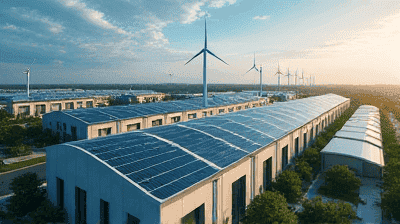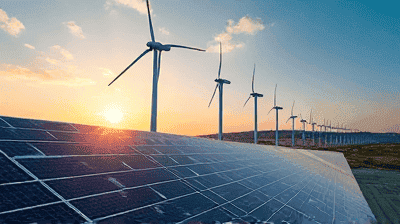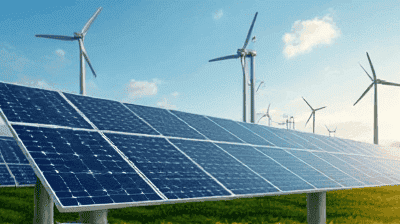
The manufacturing sector is one of the largest consumers of energy in the world, contributing significantly to greenhouse gas emissions and environmental degradation. As industries face increasing pressure to reduce their carbon footprints and transition to more sustainable practices, renewable energy sources like solar and wind power have emerged as viable alternatives.
Renewable energy is derived from natural sources that are replenished at a rate equal to or faster than the consumption rate. Unlike fossil fuels, which are finite and contribute to environmental pollution, renewable energy sources are sustainable and have lower environmental impacts. The main types of renewable energy include solar power, wind power, hydroelectric power, biomass, and geothermal energy.
Solar power is generated by converting sunlight into electricity using solar panels, also known as photovoltaic (PV) cells. These cells consist of semiconductor materials that absorb sunlight and generate direct current (DC) electricity. This electricity can then be converted into alternating current (AC) for use in manufacturing processes or fed into the electrical grid.
Wind power harnesses the kinetic energy of wind to generate electricity using wind turbines. These turbines convert the energy from wind movement into mechanical energy, which is then used to generate electricity through a generator.

One of the primary motivations for integrating renewable energy in manufacturing processes is to reduce carbon emissions. The International Energy Agency (IEA) reported that the manufacturing sector accounts for approximately 20% of global energy-related CO2 emissions. By transitioning to solar and wind power, manufacturers can significantly decrease their reliance on fossil fuels and lower their carbon footprints.
Renewable energy sources can enhance energy security for manufacturers by reducing dependence on volatile fossil fuel markets. By generating their own power or participating in local renewable energy projects, manufacturers can stabilize energy costs and mitigate the risks associated with fluctuating energy prices.
While the upfront investment in renewable energy systems can be significant, the long-term cost savings can be substantial. Solar and wind power systems typically have low operating and maintenance costs. Manufacturers that invest in renewable energy can benefit from decreased energy bills and increased operational efficiency over time.
Many governments around the world are implementing stricter environmental regulations aimed at reducing emissions and promoting renewable energy adoption. Manufacturers that transition to renewable energy can ensure compliance with these regulations and may benefit from government incentives, grants, and tax credits designed to promote sustainability.
As consumers increasingly prioritize sustainability, manufacturers that adopt renewable energy can enhance their public image and brand reputation. By demonstrating a commitment to environmental responsibility, companies can attract environmentally conscious customers and investors, improving their market position and competitiveness.
Despite the many benefits, integrating renewable energy into manufacturing processes is not without its challenges:
The initial costs associated with purchasing and installing solar panels or wind turbines can be a significant barrier for many manufacturers, especially small to medium-sized enterprises (SMEs). While the costs of renewable energy technologies have declined, the upfront capital required for installation still poses challenges.
The intermittent nature of solar and wind energy can make it difficult for manufacturers to rely exclusively on these sources. Energy storage solutions, such as batteries, can help balance supply and demand but come with their own costs and technical considerations. Manufacturers must develop effective energy management strategies to ensure a reliable power supply.
Solar and wind installations require adequate space, which can be a limiting factor for some manufacturing operations, particularly in urban areas. Companies may need to explore creative solutions, such as rooftop solar installations or community wind farms, to accommodate energy generation needs.
Integrating renewable energy systems into existing manufacturing processes requires technical expertise. Manufacturers may need to invest in training or hire specialized staff to ensure successful implementation and ongoing maintenance of renewable energy technologies.
Connecting renewable energy systems to the grid can pose regulatory challenges, including permitting processes and grid access issues. Manufacturers must navigate the complexities of local and regional regulations to ensure compliance and secure grid connections.

To illustrate the potential of renewable energy in manufacturing, we can look at several successful case studies of companies that have effectively integrated solar and wind power into their operations.
Tesla's Gigafactory in Nevada is a prime example of how manufacturing can leverage renewable energy for production. The facility produces lithium-ion batteries and electric vehicles and is designed to operate on 100% renewable energy.
Unilever, a global consumer goods company, has implemented renewable energy solutions across its manufacturing facilities to reduce emissions and enhance sustainability.
Siemens Gamesa, a leading manufacturer of wind turbines, is committed to using renewable energy in its production processes.
Coca-Cola has set ambitious sustainability goals, including a commitment to using renewable energy in its manufacturing facilities.
IKEA has implemented renewable energy initiatives across its supply chain, focusing on solar and wind power to enhance sustainability in its manufacturing processes.
To successfully integrate renewable energy into manufacturing operations, companies can adopt several key strategies:
Manufacturers should begin by conducting comprehensive energy audits to assess their current energy consumption patterns, identify opportunities for energy efficiency improvements, and determine the feasibility of renewable energy integration. This assessment will help prioritize investments in renewable energy technologies.
Engaging in power purchase agreements (PPAs) with renewable energy providers can help manufacturers secure reliable renewable energy sources without the need for direct investments in infrastructure. PPAs allow companies to buy renewable energy at fixed rates, providing cost stability and promoting sustainability.
To address the intermittency of solar and wind power, manufacturers should consider investing in energy storage systems, such as batteries, to store excess energy generated during peak production times. This stored energy can be utilized during periods of low energy generation, ensuring a consistent power supply.
Manufacturers can partner with local energy providers to explore community solar or wind projects that enable shared investments in renewable energy infrastructure. Collaborative efforts can reduce upfront costs and create more extensive renewable energy networks within communities.
Investing in training programs for employees to enhance their understanding of renewable energy technologies and sustainable practices can foster a culture of sustainability within manufacturing organizations. Educated employees can contribute valuable insights and innovations to improve energy strategies.

As the world shifts toward a more sustainable and low-carbon economy, the role of renewable energy in manufacturing is expected to grow significantly. Several future trends may shape this landscape:
Continued research and development will lead to advancements in renewable energy technologies, making them more efficient, affordable, and accessible for manufacturers. Innovations such as solar reflective materials and next-generation wind turbines may further enhance energy generation capabilities.
As governments increasingly recognize the importance of combating climate change, supportive policies and incentives for renewable energy adoption in manufacturing are likely to expand. Enhanced regulations targeting emissions reductions will also encourage the transition toward sustainable energy sources.
The shift toward decentralized energy systems, where manufacturers generate their energy onsite, is expected to continue. This trend empowers companies to have greater control over their energy supply, increasing resilience and energy independence.
The integration of renewable energy with circular economy principles will become more prevalent in manufacturing processes. Companies will seek to minimize waste, recycle materials, and utilize renewable energy to create closed-loop systems that benefit both the environment and their bottom line.
As consumers become more environmentally conscious, there will be increased demand for sustainably produced goods. Manufacturers that adopt renewable energy practices can position themselves favorably in the marketplace, appealing to eco-minded consumers.
The integration of renewable energy, particularly solar and wind power, in manufacturing represents a pivotal opportunity for industries to reduce their environmental impact, enhance operational efficiency, and improve public perception. As manufacturers increasingly recognize the importance of sustainability, the shift toward renewable energy is expected to accelerate, driven by technological advancements, regulatory support, and shifting consumer demand.
While challenges remain, the benefits of adopting renewable energy practices in manufacturing are clear. By reducing carbon emissions, lowering operational costs, and fostering innovation, manufacturers can contribute to a sustainable future while securing their competitive edge. The transition toward renewable energy is not merely a trend; it is a necessity for a resilient and sustainable manufacturing sector that prioritizes the health of our planet and society.